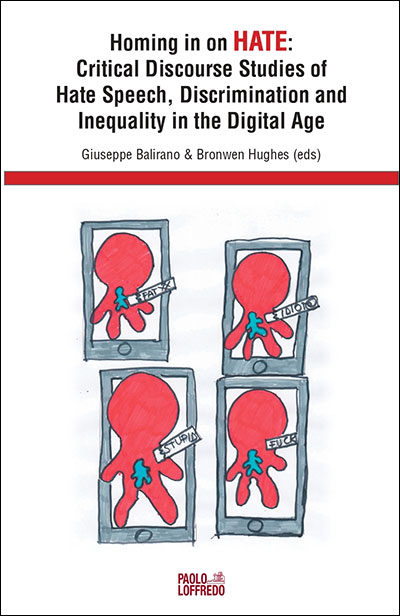Identity, Language and Diversity between walls and bridges
Language: English
Publisher: Paolo Loffredo Editore Srl

Description
Homing in on Hate: Critical Discourse Studies of Hate Speech, Discrimination and Inequality in the Digital Age
A shared definition of ‘hate speech online’ is in a constant flux due to the supranational character of the internet, the slippery nature of online harassment, and the porous relationship between actual violence and discriminatory speech. Besides the hateful messages propagated across social networking platforms and micro-blogging sites, the recent rise of live-streamed hate has also captured public attention forcing governments and internet providers to contend with the issue of how to prevent and punish such online activities.
As the contributors highlight throughout this volume, the term ‘hate’ itself is extremely difficult to define, stemming as it does from the extremes of socio-psychopathic impulses, an inability to regulate emotions adequately, or merely from a lack of empathy. In some cases, the denigrators do not even hate their victims, they are merely pliable individuals who feel the need to emulate the sentiments of a strong cohort of denigrators in order to gain ‘insider’ status. Such individuals, however, are no less to blame than the hate mongers themselves, since they actively contribute to an echo chamber which serves to amplify and reinforce the hatred deployed. Whether they truly detest their targets or merely emulate the apparently dominant group, the aim of haters, be they online or offline, is to relegate the victims to a generic category of ‘others’, and in hate speech the other is always the enemy. The differences between the ‘us’ belonging to the dominant grouping, and the ‘them’ banished to the out-group are magnified in hate speech: the insiders are safe, legitimate, normal and rational, the outsiders are dangerous, different, threatening, and antagonistic.
Although the focus of this volume concerns, in the main, the digital environment, the editors and contributors are all well aware that ‘hate speech online’ does not occur in a virtual vacuum, its effects are dramatically real for those individuals who are on the receiving end. Cyberbullying and hate speech impinge upon the lives of individuals from social, economic, professional and psychological backgrounds, and increase the sense of fear and vulnerability of entire communities. The ever-encroaching discourse of online hate has, to date, only been partially mapped, and available studies have mostly focused on forms of misogynous attacks in the male-dominated online tech and gamer communities or against feminist activists. Additionally, there seems to be a tendency to forget that ongoing, low-level hate speech is far more common than the dramatically violent hate crimes that capture public imagination.
Whether by investigating the ripple effect triggered by a single controversial tweet, the manipulation of gender ideologies in ethnic radio discourse, or the re-semiotization of the ‘city’ as a nurturing space for Jihadist hate narratives, this book intends to address, from a wide and comprehensive multimodal perspective, the prevailing gaps in research literature and the dire need to contend with rampant vitriolic discourses today.
Autori
Giuseppe Balirano, PhD in English for special purposes, is full professor SSD: L-LIN / 12 (English language and translation) at the Department of Literary, Linguistic and Comparative Studies of the University of Naples "l'Orientale"
Bronwen Hughes is a researcher at the Parthenope University in Naples. She holds a PhD in Linguistics and Modern and Comparative Literature and her research interests lie in the fields of translation as a tool for second language acquisition, cross-cultural media studies, and forensic linguistics. Her current research interests center upon the linguistic analysis of first-hand migrant narratives collected in Italy and the UK, and on the investigation of English language CLIL and EMI teaching methodologies in Italian educational contexts.




